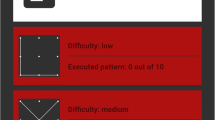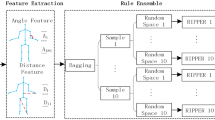Abstract
The recognition of affective human communication may be used to provide developers with a rich source of information for creating systems that are capable of interacting well with humans. Posture has been acknowledged as an important modality of affective communication in many fields. Behavioral studies have shown that posture can communicate discrete emotion categories as well as affective dimensions. In the affective computing field, while models for the automatic recognition of discrete emotion categories from posture have been proposed, to our knowledge, there are no models for the automatic recognition of affective dimensions from static posture. As a continuation of our previous study, the two main goals of this study are: i) to build automatic recognition models to discriminate between levels of affective dimensions based on low-level postural features; and ii) to investigate both the discriminative power and the limitations of the postural features proposed. The models were built on the basis of human observers’ ratings of posture according to affective dimensions directly (instead of emotion category) in conjunction with our posture features.
Preview
Unable to display preview. Download preview PDF.
Similar content being viewed by others
References
Argyle, M.: Bodily Communication. Methuen & Co. Ltd., London (1988)
Bianchi-Berthouze, N., Kleinsmith, A.: A categorical approach to affective gesture recognition. Connection Science 15, 259–269 (2003)
Camurri, A., Hashimoto, S., Suzuki, K., Trocca, R.: Kansei analysis of dance performance. In: IEEE Int’l Conf. on Systems, Man and Cybernetics, pp. 327–332 (1999)
Camurri, A., Volpe, G., De Poli, G., Leman, M.: Communicating Expressiveness and Affect in Multimodal Interactive Systems. IEEE Multimedia 12, 43–53 (2005)
Coulson, M.: Attributing emotion to static body postures: recognition accuracy, confusions, and viewpoint dependence. Jour. of Nonv. Behav. 28, 117–139 (2004)
Davitz, J.: Auditory correlates of vocal expression of emotional feeling. In: Davitz, J. (ed.) The Communication of emotional Meaning, pp. 101–112. McGraw-Hill, New York (1964)
de Gelder, B., Snyder, J., Greve, D., Gerard, G., Hadjikhani, N.: Fear fosters flight: A mechanism for fear contagion when perceiving emotion expressed by a whole body. Proc. of the National Academy of Science 101(47), 16701–16706 (2003)
de Silva, P.R., Bianchi-Berthouze, N.: Modeling human affective postures: An information theoretic characterization of posture features. Journal of Computer Animation and Virtual Worlds 15, 269–276 (2004)
de Silva, P., Kleinsmith, A., Bianchi-Berthouze, N.: Towards unsupervised detection of affective body posture nuances. In: Tao, J., Tan, T., Picard, R.W. (eds.) ACII 2005. LNCS, vol. 3784, pp. 32–39. Springer, Heidelberg (2005)
Ekman, P., Friesen, W.: Head and body cues in the judgment of emotion. A reformulation, Perceptual and Motor Skills 24, 711–724 (1967)
Harrigan, J., Rosenthal, R.: Physicians head and body positions as determinants of perceived rapport. Journal of of Applied Social Psychology 13(6), 496–509 (1983)
Hastie, T., Tibshirabi, R.: Discriminant analysis by Gaussian mixture. Journal of the Royal Statistical Society B:58, 155–176 (1996)
James, W.T.: A study of the expression of bodily posture. Journal of General Psychology 7, 405–437 (1932)
Kamisato, S., Odo, S., Ishikawa, Y., Hoshino, K.: Extraction of motion characteristics corresponding to sensitivity information using dance movement. Journal of Advanced Computational Intelligence and Intelligent Informatics 8(2), 167–178 (2004)
Kapoor, A., Picard, R., Ivanov, Y.: Probabilistic combination of multiple modalities to detect interest. Proc. of the 17th International Conference on Pattern Recognition 3, 969–972 (2004)
Kleinsmith, A., Fushimi, T., Bianchi-Berthouze, N.: An incremental and interactive affective posture recognition system. In: Ardissono, L., Brna, P., Mitrović, A. (eds.) UM 2005. LNCS (LNAI), vol. 3538, Springer, Heidelberg (2005)
Kleinsmith, A., de Silva, P., Bianchi-Berthouze, N.: Cross-cultural differences in recognizing affect from body posture. Interacting with Computers 18, 1371–1389 (2006)
Kleinsmith, A., de Silva, P., Bianchi-Berthouze, N.: Grounding affective dimensions into posture features. In: Proceedings of the First International Conference on Affective Computing and Intelligent Interaction, pp. 263–270. Springer, Heidelberg (2005)
Lachenbruch, P.A.: Discriminant Analysis, NY, Hafner (1975)
Mehrabian, A., Friar, J.: Encoding of attitude by a seated communicator via posture and position cues. Journal of Consulting and Clinical Psychology 33, 330–336 (1969)
Mehrabian, A.: Inference of attitude from the posture, orientation, and distance of a communicator. Journal of Consulting and Clinical Psychology 32, 296–308 (1968)
Mehrabian, A., Russell, J. (eds.): An Approach to Environmental Psychology. MIT Press, Cambridge (1974)
Osgood, C., Suci, G., Tannenbaum, P.: The measurement of meaning. University of Illinois Press, Chicago (1957)
Woo, W., Park, J., Iwadate, Y.: Emotion analysis from dance performance using time-delay neural networks. Proc. of the JCIS-CVPRIP 2, 374–377 (2000)
Wundt, W.: Outlines of psychology. Wilhelm Englemann, Leipzig (1907)
Author information
Authors and Affiliations
Editor information
Rights and permissions
Copyright information
© 2007 Springer-Verlag Berlin Heidelberg
About this paper
Cite this paper
Kleinsmith, A., Bianchi-Berthouze, N. (2007). Recognizing Affective Dimensions from Body Posture. In: Paiva, A.C.R., Prada, R., Picard, R.W. (eds) Affective Computing and Intelligent Interaction. ACII 2007. Lecture Notes in Computer Science, vol 4738. Springer, Berlin, Heidelberg. https://doi.org/10.1007/978-3-540-74889-2_5
Download citation
DOI: https://doi.org/10.1007/978-3-540-74889-2_5
Publisher Name: Springer, Berlin, Heidelberg
Print ISBN: 978-3-540-74888-5
Online ISBN: 978-3-540-74889-2
eBook Packages: Computer ScienceComputer Science (R0)




